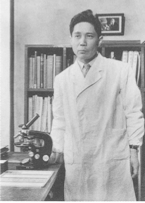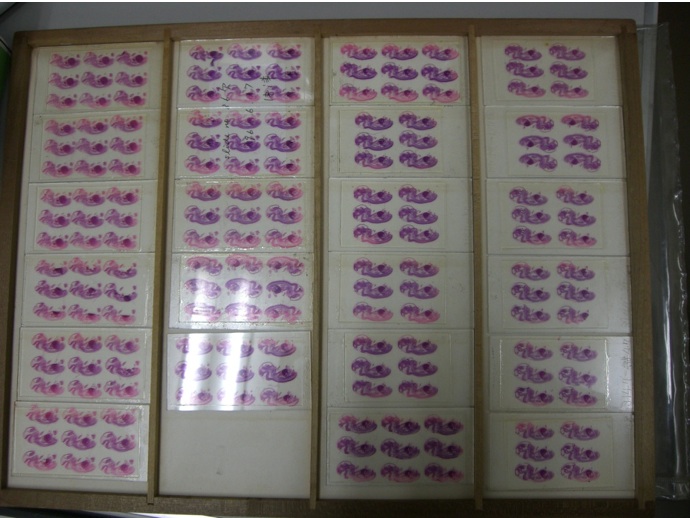1.1 Founding of the Kyoto Collection

Hideo Nishimura, Prof. in the Department of Anatomy at Kyoto University School of Medicine, instigated a collection of human conceptuses in 1961. Induced abortions were then legal in Japan under the Maternity Protection Law of Japan. Therefore, pregnancies were terminated for social reasons during the first trimester in a great majority of cases. The Congenital Anomaly Research Center was founded at Kyoto University, School of medicine in 1975, when the number of specimens reached over 36,000. The embryo collection comprises over 45,000 specimens nowadays, which represents the largest human embryo collection in the world.
Over 70% of the embryos were collected in the 1960s and 25.5% in the 1970s. The less than 5% of the specimens joined KC between 1980 and 1999 (Kameda et al, 2011). The specimens were collected from a total of 22 prefectures in six different districts; Kansai, Tokai, Hokuriku, Kanto, Chugoku/Shikoku with aid of approximately 1400 obstetrician.
1.2. How were so many samples collected?
The majority of the specimens were obtained after termination of pregnancy by dilatation or curettage during the first trimester for socioeconomic reasons. Other specimens resulted from spontaneous or threatened abortions. Dilatation and curettage (therapeutic abortions) given to healthy women enabled acquisition of undamaged, intact embryos. Approximately 20% of the specimens are undamaged, well-preserved embryos.
When the aborted materials were brought to our laboratory, the embryos were measured, staged, and examined for gross external abnormalities and presence of intrauterine death under a dissecting microscope. The developmental stage of the embryos (Carnegie stage: CS) was determined according to the criteria proposed by O’Rahilly and Müller (1987). Most of the specimens are between the CS13 and CS23, which is the critical period of teratogenesis. The specimens were fixed in 4% formaldehyde or Bouin solution and stored in 4% formaldehyde.

1.3. Feature of Kyoto Collections
Since the attending obstetricians were not involved in examining the aborted materials, Embryos were collected in a random manner. The collection of embryos was not biased by their outcome (e.g., normal or abnormal, live or dead), thus, the embryo collection is considered representative of the unbiased total intrauterine population in Japan (Nishimura, 1974, 1975, Shiota 1991) Using this representative embryo population, it was reported that the incidence of malformations in embryos were more frequent than that in infants (Nishimura et al., 1968), and that embryos with severe malformations were prone to spontaneous abortion at high rates (Shiota, 1991).
2) KC comprises embryo specimens with a large variety of external malformations as reported by previously published studies (Nishimura et al. 1968; Matsunaga and Shiota 1977; Yamada et al. 2004). Approximately 7.8% of the embryos exhibit external anomalies and 92.2% are without anomalies, which provide a unique opportunity to study the early stages of abnormal morphogenesis. The three most common anomalies were nuchal bleb, holoprosencephaly and spina bifida. Holoprosencephaly is encountered much more frequently (1/250 or more) in the unselected early human embryonic population (Matsunaga and Shiota, 1977).
3) Well-preserved samples were stored and some of them were selected to be sectioned serially; a total of 500 normal embryos and 500 abnormal embryos were stored as complete serial sections, including HPE embryos. All histological sections comprised in the library is plan to be digitalized. The project is currently focusing on serial sections of normal embryos. Parts of the digitized serial sections are accessible from our website (http://atlas.cac.med. kyoto-u.ac.jp).
4) Most specimens were collected along with detailed clinical and epidemiological information on the associated pregnancies and the mothers. These data were accumulated in the formats of paper sheets and punch cards. All data gathered in KC were turn into dizitalized textual and imaging data recently (Kameda et al 2011).
1.4 Ethics and legal point of view
The embryo specimens of KC were collected and stored legally and ethically in Japan in the first place.
After World War II, a lot of laws were established in Japan to reconstruct the country. The Eugenic Protection Law was one of such laws, and established in 1948. Revision of the law in 1952 made artificial abortion in early periods of pregnancy legally available by the articles as same as present Maternal Protection Law. Prof. Nishimura explained in his book about the rationale of this human embryo collection by “Japanese Eugenic Protection Law in 1952 (Nishimura 1975). The legal basis for artificial abortion in found in the 1st item of article 14 in Chapter III (Protection of the mother’s life and health) of the law as cited as follows (Nishimura 1966); ‘The physician designated by the Medical Association, which is a corporate juridical body established in the prefectural district as a unit, may exercise artificial interruption of pregnancy, at his discretion, on the person, who falls under any of the following items with consent of the person in question and the spouse: First item: A mother, whose health may be affected seriously by continuation of pregnancy or by delivery from the physical view point or economically’ (Nishimura 1966). Thus, in Japan, a lot of operations of artificial abortion have been performed for the reasons of economical reason. After the operation, embryo and placenta (or decidua) were taken out from maternal body and small embryos before 12 weeks of gestation and placenta were usually disposed as hospital waste. Prof. Nishimura planned to use the human embryo and placenta disposed as hospital waste for the research to elucidate the nature of embryonic morphology. He and his colleagues solicited the cooperation of the obstetricians who explained to their clients the significance of medical research and the contributions the parents could make by leaving the embryos with them. In most cases the mothers acceded to the requests of the obstetricians in whom they had trust. In addition, we regarded ourselves as an extension of the obstetrician’s clinic and could accept the specimens in good faith. The embryos were transferred to our laboratory with their some information such as date of operation, gestational ages, etc., but had no identifying information and cannot be linked to the parents or any relatives. Thus, the operations of artificial abortion could only be performed under the reasons based on the law, with the consent of mother and/or the father. The scientist or obstetrician could force mothers neither to take operation and nor to give the embryo to the scientist or obstetrician.
Therefore, the embryos have been obtained ethically. It is not appropriate to treat the Kyoto Collection and victims of Holocaust. Based on these backgrounds, our research have been approved by IRB of Kyoto University (The Committee of Medical Ethics of Kyoto University Graduate School of Medicine, Kyoto: E986, G377).







